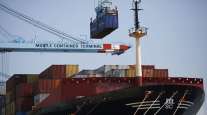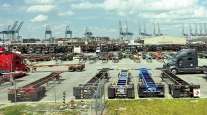Second-Quarter Surge Has Intermodal on Pace for New Record
This story appears in the July 16 print edition of Transport Topics.
Intermodal shipments that surged late in the second quarter have pushed 2012 truck/rail freight volume ahead of the record pace set in 2006, the Association of American Railroads reported.
Domestic, rather than international, intermodal shipments are driving this year’s increase, a top industry official and the president of the industry trade association told Transport Topics.
Shipments through the first 26 weeks of 2012 that ended June 30 totaled 6.05 million, or 20,000 more than the same time period for the record year. Intermodal’s 2012 volume trailed 2006 levels until late May, when a surge began that included the rails’ best June ever.
“The recovery can be attributed to domestic intermodal,” said Steve Branscum, consumer products vice president at BNSF Railway, whose annual intermodal volume of 4.5 million shipments tops the industry. “The future is extremely bright for intermodal both for BNSF and the industry.”
Branscum told TT that domestic intermodal growth is being driven by highway-to-intermodal conversions that have been accelerating, even through the recession, while international freight more tied to the economy has stagnated.
Industrywide, the full-year 2006 intermodal record volume totaled 14.3 million shipments, 40% of which were domestic. By 2011, domestic intermodal accounted for 47% of loads and totaled 930,000 more than in 2006.
“There is no doubt whatsoever that domestic intermodal is growing by leaps and bounds,” said Joni Casey, president of the Intermodal Association of North America.
Casey said domestic intermodal is up 16% so far this year, over and above the steady increase in recent years.
Precise domestic growth totals won’t be available until next month, when IANA publishes its quarterly intermodal market report. AAR’s statistics don’t provide a breakdown of domestic vs. international intermodal freight.
“There is the reality or the perception of a tightening of capacity in the truckload market,” Casey told TT. “That is driving some traffic to intermodal because the service and price is conducive to that. There is a hedging on the part of customers who want to cover all their bases.”
BNSF has increased the number of asset-based truckers and third-party logistics operators who use intermodal by 25% to 250 since the beginning of 2011.
Dry-van truckload continues to be the largest potential growth area, Branscum said, although opportunities are increasing for refrigerated and flatbed moves.
“Once a load is converted from highway to intermodal, it is not easily shifted back,” said Thom Albrecht, a BB&T Capital Markets analyst, in an investor note, citing comments from customers. His report focused on J.B. Hunt Transport Services, which moved 1.25 million intermodal loads last year.
Hunt’s freight volume, which has grown at 13% or more on a year-over-year basis for 11 straight quarters, represented nearly 9% of last year’s total intermodal volume.
A factor that could curtail future growth, Albrecht’s report said, is the multiyear trend by some truckload carriers to move more regional freight, which travels shorter distances and isn’t conducive to intermodal diversion from the highway.
A key factor in further improving intermodal volume is to speed up the still slow hand off of freight from one railroad to another, which typically adds one day of travel time for loads moved by two railroads, Branscum said.
The slowdowns occur particularly in places like Chicago, where railroads hand off freight to one another in quantities smaller than an entire train load, he said.
“Most interline moves happen with cross-towns [truck moves of a single container from one rail terminal to another] or less than trainload volumes,” Branscum said. “Both of those options take time.”
The rail-to-rail connection process could be helped by new CSX and Norfolk Southern terminals to speed that hand off, he said.
Branscum illustrated the scope of further intermodal growth by citing research done by BNSF, Fort Worth, Texas, that shows 10 million more highway loads could be converted to truck/rail moves.
The research is supported by the fact that a small group of 150 shippers moving 3 million annual loads already have asked BNSF to evaluate their freight flows for intermodal opportunities, he added.
“A fair portion of those 10 million loads is transcontinental freight that is still on the highway because existing rail service doesn’t meet customer needs,” Branscum said.




